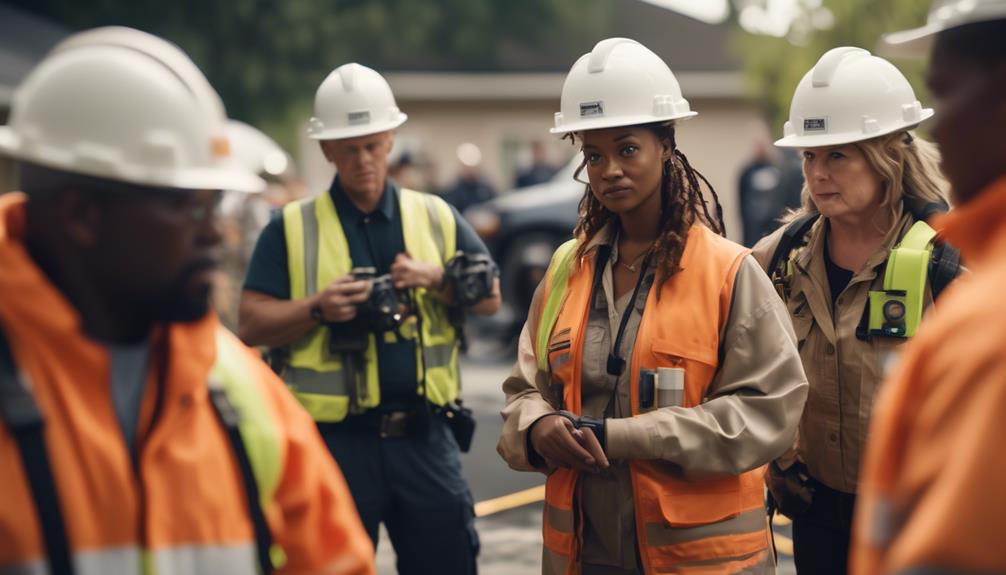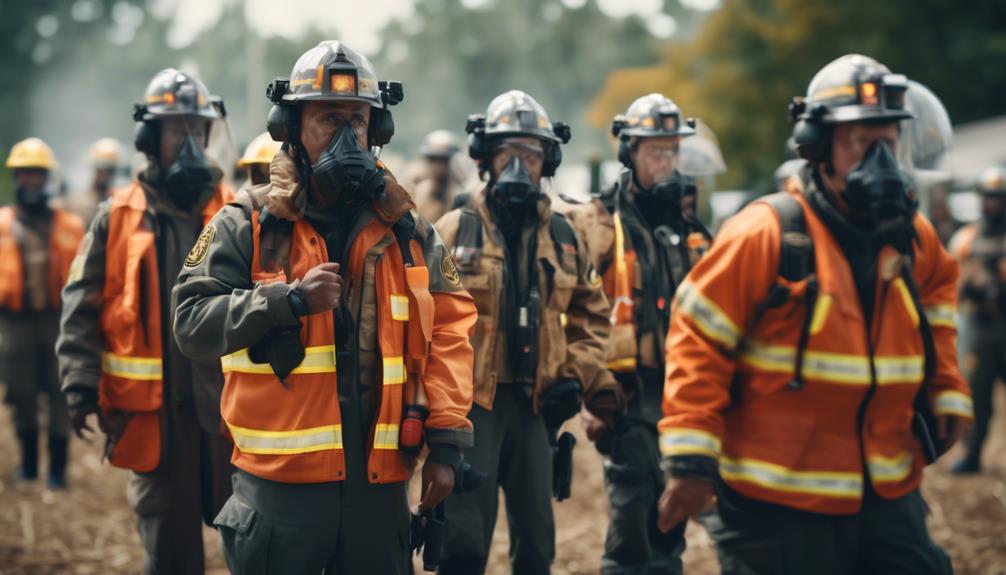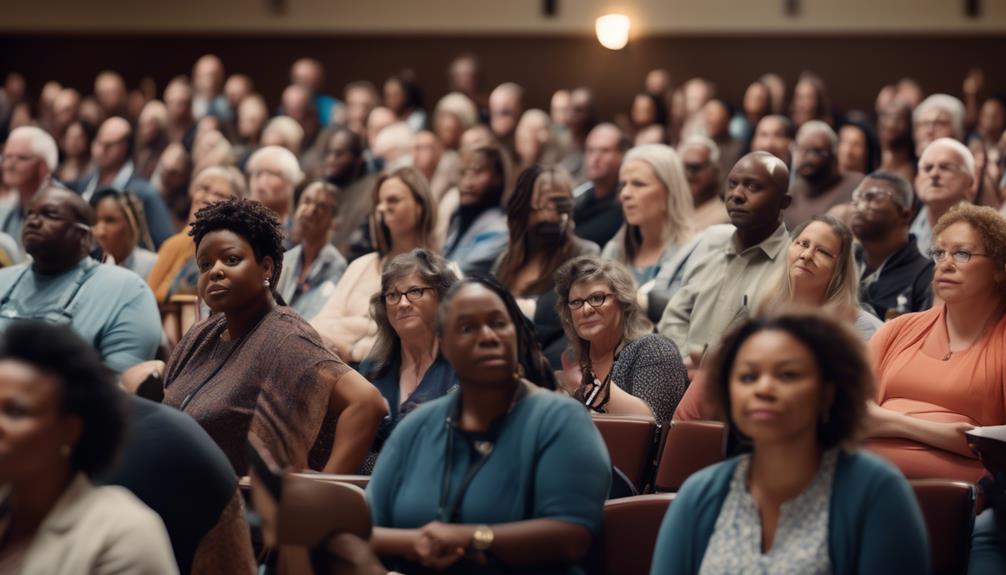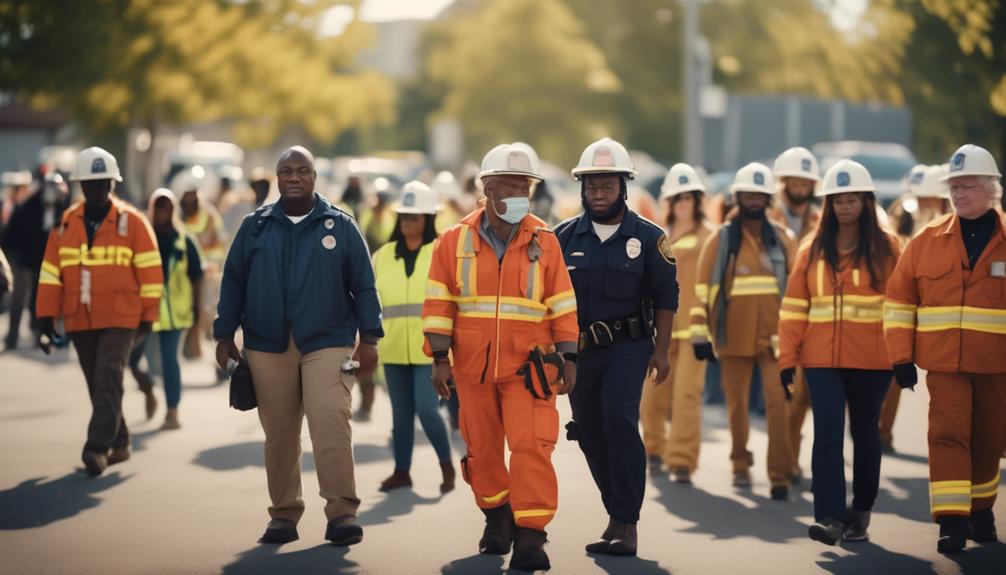In today's uncertain world, it is crucial to ensure that communities are actively involved in preparedness efforts. The ability to effectively respond to and recover from disasters depends largely on the collective strength and resilience of a community. Engaging communities in preparedness efforts not only fosters a culture of preparedness, but also strengthens bonds among community members. By sharing knowledge and skills, enhancing early warning systems, mobilizing local resources, fostering effective communication channels, and empowering individuals and neighborhoods, communities can become better equipped to face any potential crisis. But why is community engagement in preparedness efforts so important? Let's explore further.
Key Takeaways
- Collaboration among individuals, organizations, and government agencies is crucial for building a culture of preparedness.
- Empowering local participation and fostering community bonds enhances resilience and the ability to face emergencies.
- Early warning systems play a vital role in disaster management by providing timely and accurate information to communities.
- Mobilizing local resources and fostering effective communication channels are essential for engaging communities in preparedness efforts.
Building a Culture of Preparedness

Building a Culture of Preparedness is essential for fostering resilience and ensuring the safety and well-being of communities in the face of potential disasters. Creating resilience within a community requires a proactive approach that involves collaboration and engagement from all members. By building a culture of preparedness, communities can enhance their ability to respond effectively and recover quickly from any adverse event.
Community collaboration plays a vital role in building a culture of preparedness. When individuals, organizations, and government agencies work together, they can pool resources, knowledge, and expertise to develop comprehensive disaster preparedness plans. This collaboration fosters a sense of shared responsibility and empowers the community to take ownership of their preparedness efforts.
One way to create resilience within a community is by promoting education and awareness. By providing information about potential hazards, emergency response procedures, and the importance of preparedness, individuals can make informed decisions and take appropriate actions during a crisis. This knowledge empowers individuals to become active participants in their own safety and the safety of their community.
Furthermore, building a culture of preparedness involves encouraging individuals to develop personal emergency plans and assemble emergency supply kits. These steps help individuals become self-reliant and reduce the strain on emergency services during times of crisis. Additionally, community-wide drills and exercises can help familiarize residents with emergency procedures, improve response times, and strengthen coordination among various entities.
Strengthening Community Bonds
Strengthening community bonds is crucial in building a culture of preparedness. By fostering trust and unity among community members, they can work together towards common goals, such as disaster preparedness. Empowering local participation ensures that everyone has a voice and can contribute their skills and knowledge to enhance collective resilience.
Building Trust and Unity
By fostering a sense of trust and unity within a community, preparedness efforts can be more effectively implemented and sustained. Building community and increasing collaboration are crucial in this regard. When community members trust and support one another, they are more likely to work together towards a common goal, such as disaster preparedness. By establishing strong bonds, individuals are more likely to share information, resources, and expertise, leading to a more comprehensive and efficient preparedness plan. Trust and unity also contribute to a sense of collective responsibility and resilience, as community members become invested in each other's well-being. This unity can further strengthen the community's ability to respond to and recover from emergencies. Overall, building trust and unity within a community is essential for successful preparedness efforts.
Empowering Local Participation
To foster stronger community bonds and encourage local participation in preparedness efforts, it is crucial to empower individuals and organizations within the community. By promoting self-reliance and encouraging active involvement, communities can become more resilient and better equipped to handle emergencies and disasters. Here are three key ways to empower local participation:
- Provide education and training: Offering workshops, seminars, and training programs on emergency preparedness can equip community members with the necessary knowledge and skills to respond effectively in times of crisis.
- Establish community-led initiatives: Encouraging the formation of local task forces or committees focused on preparedness allows community members to take ownership of their safety and contribute to decision-making processes.
- Foster partnerships and collaboration: Building strong relationships between community organizations, local government agencies, and emergency services can enhance coordination and cooperation, ensuring a more comprehensive and efficient response to emergencies.
Enhancing Collective Resilience
Fostering strong community bonds is essential for enhancing collective resilience in times of crisis. When individuals come together and take collective action, they can better navigate and overcome challenges. Community engagement plays a crucial role in building these bonds and promoting resilience. It creates a sense of belonging, trust, and shared responsibility, which are vital for effective preparedness efforts. Engaging the community allows for the exchange of knowledge, resources, and support, strengthening the overall capacity to respond to emergencies.
To illustrate the significance of community engagement in enhancing collective resilience, consider the following table:
| Benefits of Community Engagement | ||
|---|---|---|
| Increased awareness and preparedness | Enhanced communication and coordination | Improved problem-solving abilities |
| Shared resources and support networks | Greater sense of belonging and empowerment |
Sharing Knowledge and Skills
Communities can enhance preparedness efforts by actively sharing their knowledge and skills. By engaging in collaborative learning and skill exchange, communities can build a strong foundation of resilience that will enable them to better respond to and recover from emergencies and disasters. Here are three key reasons why sharing knowledge and skills is crucial in preparedness efforts:
- Increased Preparedness: When community members share their knowledge and skills, they contribute to a collective pool of resources and expertise. This enables individuals to learn from one another and acquire new skills that can be invaluable during emergencies. For example, someone with medical training can teach others basic first aid techniques, while individuals with construction experience can share knowledge on building temporary shelters. This exchange of knowledge ensures that the community is better equipped to respond effectively in times of crisis.
- Diverse Perspectives: Sharing knowledge and skills allows for a diversity of perspectives and approaches to problem-solving. Each individual brings their unique experiences and expertise to the table, which enriches the overall preparedness efforts. By encouraging collaboration and open dialogue, communities can tap into a wide range of ideas and strategies, leading to more innovative and effective solutions.
- Empowerment and Self-Sufficiency: Sharing knowledge and skills empowers individuals within the community to take an active role in their own preparedness. By learning from one another, community members can develop the confidence and abilities necessary to respond to emergencies independently. This not only reduces reliance on external assistance but also fosters a sense of self-sufficiency and resilience within the community.
Enhancing Early Warning Systems

Building on the importance of sharing knowledge and skills in preparedness efforts, another critical aspect to consider is enhancing early warning systems. Improving response time and promoting community ownership are key factors in ensuring effective and efficient disaster preparedness.
Early warning systems play a crucial role in disaster management by providing timely and accurate information about impending hazards. By detecting potential threats such as natural disasters, extreme weather events, or public health emergencies, early warning systems enable communities to take proactive measures to protect lives and minimize damage. Enhancing these systems is essential for saving lives and reducing the negative impact of disasters.
Improving response time is one of the primary objectives of enhancing early warning systems. By reducing the time between the issuance of a warning and the community's response, individuals can take appropriate actions to mitigate risks and evacuate if necessary. This can significantly reduce the loss of life and property damage during disasters. Efforts to enhance early warning systems should focus on utilizing advanced technologies, such as automated alert systems, satellite monitoring, and real-time data analysis, to ensure timely dissemination of warnings.
Promoting community ownership is equally important in enhancing early warning systems. Communities must be actively involved in the development, implementation, and maintenance of these systems. By empowering local communities to take ownership, they can better understand the risks they face and the actions they need to take in response to warnings. This can foster a sense of responsibility and resilience within the community, enabling them to respond effectively to disasters.
Mobilizing Local Resources
To effectively mobilize local resources, it is crucial to establish clear channels of communication and coordination within the community. By creating partnerships and utilizing community assets, communities can effectively prepare for and respond to emergencies and disasters. Here are three key ways to mobilize local resources:
- Identify and engage community leaders: Community leaders play a vital role in mobilizing local resources. They have the knowledge and influence to rally community members, organize efforts, and allocate resources effectively. By involving community leaders in preparedness efforts, their expertise and connections can be leveraged to engage a wider range of community assets.
- Develop community-based organizations: Community-based organizations (CBOs) are grassroots organizations that focus on specific community needs. These organizations can be valuable partners in preparedness efforts as they have a deep understanding of local challenges and resources. By collaborating with CBOs, emergency management agencies can tap into their networks, expertise, and resources, which can significantly enhance the community's resilience.
- Foster a culture of volunteerism: Volunteers are a valuable resource during emergencies and disasters. By fostering a culture of volunteerism within the community, individuals can contribute their time, skills, and resources to support preparedness and response efforts. This can be achieved by organizing volunteer training programs, establishing volunteer networks, and recognizing and rewarding volunteer contributions. By mobilizing volunteers, communities can build a strong and resilient response capacity.
Fostering Effective Communication Channels

Establishing effective communication channels is essential for fostering community engagement in preparedness efforts. Improving information dissemination and encouraging collaboration are key components of creating these channels. By ensuring that the right information reaches the right people at the right time, communities can be better prepared to respond to emergencies and disasters.
One way to improve information dissemination is through the use of various communication tools and platforms. This could include traditional methods such as flyers, posters, and community meetings, as well as modern technologies like social media, email, and text messaging. By utilizing a combination of these channels, community members can receive timely updates, instructions, and resources to help them prepare for emergencies.
To illustrate the importance of effective communication channels, a table is provided below:
| Communication Channel | Advantages | Disadvantages |
|---|---|---|
| Social Media | – Wide reach – Fast dissemination of information – Interactive and engaging | – Limited access for some individuals – Potential for misinformation |
| Community Meetings | – Face-to-face interaction – Opportunity for discussion and questions – Builds trust and camaraderie | – Limited attendance – Time-consuming – Language and cultural barriers |
| – Direct communication – Organized and searchable – Can reach a large number of people | – Reliance on internet connectivity – Risk of messages being ignored or overlooked | |
| Text Messaging | – Immediate delivery – High open and response rates – Can reach a wide audience | – Limited character count – Potential for confusion or misinterpretation |
Empowering Individuals and Neighborhoods
An essential aspect of community preparedness efforts is empowering individuals and neighborhoods to take an active role in their own safety and resilience. By promoting neighborhood empowerment and individual empowerment, communities can become more resilient and better prepared to face any challenges that may arise. Here are three key reasons why empowering individuals and neighborhoods is crucial in community preparedness efforts:
- Increased self-reliance: When individuals and neighborhoods are empowered, they become more self-reliant in times of crisis. By providing them with the knowledge and resources to handle emergencies, they can take immediate action to protect themselves and their neighbors. This reduces the strain on external resources and allows emergency responders to focus on the most critical situations.
- Building stronger networks: Empowering individuals and neighborhoods fosters a sense of community and belonging. When people know their neighbors and the resources available within their community, they can work together more effectively during emergencies. They can share information, offer support, and coordinate efforts, leading to a stronger and more cohesive community response.
- Sustainable preparedness: When individuals and neighborhoods are empowered, they are more likely to engage in long-term preparedness efforts. They can take proactive steps to mitigate risks, such as creating emergency plans, stockpiling supplies, and participating in training programs. This sustainable approach to preparedness ensures that communities are better equipped to handle future emergencies.
Frequently Asked Questions
How Do Communities Play a Role in Building a Culture of Preparedness?
Communities play a crucial role in building a culture of preparedness by fostering resilience and promoting community engagement. By actively involving community members in preparedness efforts, individuals become more knowledgeable about potential risks and are better equipped to respond effectively in times of crisis. Additionally, community engagement encourages collaboration, resource sharing, and the development of strong social networks, which are essential for effective disaster response and recovery. Building a culture of preparedness within communities is vital to ensure the safety and well-being of individuals and the overall resilience of the community.
What Are Some Strategies for Strengthening Community Bonds in Preparedness Efforts?
Strengthening community bonds through collaboration and community engagement strategies is crucial in preparedness efforts. By fostering a sense of unity and shared responsibility, communities can become more resilient and better equipped to face emergencies. Strategies such as community meetings, workshops, and training sessions can facilitate knowledge sharing and skill development. Building trust and communication channels among community members is essential for effective disaster response and recovery. Engaging communities in preparedness efforts enhances overall preparedness levels and promotes a culture of resilience.
Effective communication and community workshops are key to sharing knowledge and skills within communities for preparedness. By providing clear and concise information through various communication channels, such as workshops, webinars, and online platforms, community members can learn about important preparedness measures and acquire the necessary skills. Engaging communities in this way fosters a sense of empowerment and collective responsibility, ensuring that everyone is well-equipped to respond to emergencies and contribute to overall community resilience.
What Are Some Examples of Enhancing Early Warning Systems in Preparedness Efforts?
Enhancing early warning systems is crucial in preparedness efforts as it enables timely response and minimizes the impact of disasters. By leveraging technology, communities can receive real-time alerts and updates, allowing them to take necessary actions swiftly. For instance, implementing automated monitoring systems for weather conditions or seismic activities can provide advanced warnings, giving people more time to evacuate or mitigate potential risks. By enhancing early warning systems, communities can strengthen their preparedness, increase resilience, and ultimately save lives.
How Can Local Resources Be Mobilized to Support Community Preparedness Initiatives?
Local resources can be mobilized to support community preparedness initiatives through the establishment of local partnerships and volunteer networks. These partnerships can involve collaboration between government agencies, non-profit organizations, businesses, and community members. By leveraging local resources such as community centers, schools, and local businesses, communities can enhance their preparedness efforts. Volunteer networks can be formed to provide additional support and manpower in implementing preparedness initiatives, such as organizing training programs, conducting outreach activities, and coordinating emergency response efforts. This grassroots approach ensures that community members are actively involved in their own preparedness and resilience.
Conclusion
In conclusion, engaging communities in preparedness efforts is crucial for building a culture of preparedness, strengthening community bonds, sharing knowledge and skills, enhancing early warning systems, mobilizing local resources, fostering effective communication channels, and empowering individuals and neighborhoods. According to a study conducted by the Federal Emergency Management Agency (FEMA), communities that actively participate in preparedness efforts are 75% more likely to successfully respond to and recover from disasters. Therefore, it is imperative to involve communities in preparedness initiatives to ensure better resilience and response in times of crisis.

